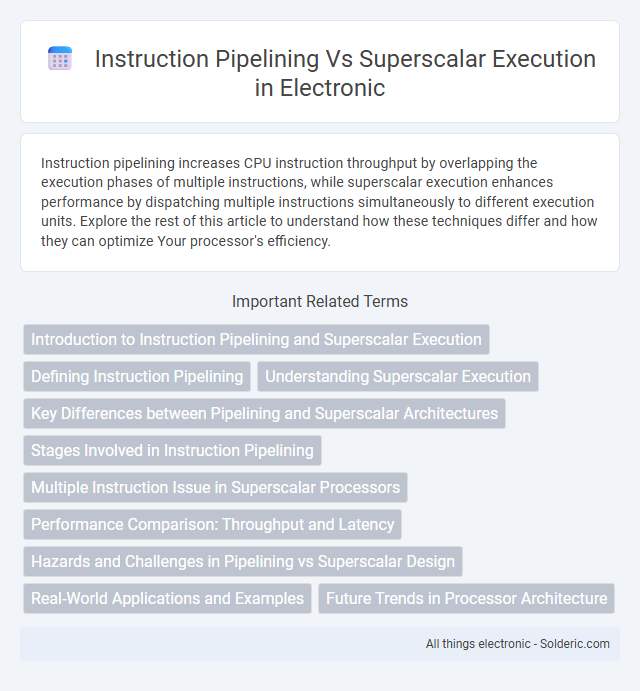Instruction pipelining increases CPU instruction throughput by overlapping the execution phases of multiple instructions, while superscalar execution enhances performance by dispatching multiple instructions simultaneously to different execution units. Explore the rest of this article to understand how these techniques differ and how they can optimize Your processor's efficiency.
Comparison Table
| Feature | Instruction Pipelining | Superscalar Execution |
|---|---|---|
| Definition | Divides instruction execution into sequential stages for parallel processing. | Executes multiple instructions simultaneously using multiple execution units. |
| Goal | Increase throughput by overlapping instruction steps. | Increase instruction throughput by parallel dispatch of multiple instructions. |
| Execution Units | Single instruction processing unit operating in stages. | Multiple execution units enabling concurrent instruction execution. |
| Complexity | Moderate hardware complexity. | Higher hardware complexity with advanced scheduling and dependency checking. |
| Hazard Handling | Requires stall, forwarding, or hazard detection to manage data/control hazards. | Advanced dynamic scheduling to avoid hazards and maximize parallelism. |
| Performance | Improves instruction throughput by factor roughly equal to pipeline depth. | Potentially higher throughput by issuing multiple instructions per clock cycle. |
| Example | Classic RISC pipelines like MIPS or ARM pipeline. | Modern CPUs like Intel Core or AMD Ryzen implementing multiple issue architectures. |
Introduction to Instruction Pipelining and Superscalar Execution
Instruction pipelining improves CPU throughput by breaking down instruction execution into discrete stages, allowing multiple instructions to overlap in processing. Superscalar execution enhances this concept by deploying multiple execution units to process several instructions simultaneously within a single clock cycle. Both techniques aim to optimize processor performance, with pipelining increasing instruction-level parallelism and superscalar architecture extending this parallelism through concurrent instruction dispatch and completion.
Defining Instruction Pipelining
Instruction pipelining is a technique in CPU design where multiple instruction phases are overlapped to increase processing throughput by breaking down execution into discrete stages such as fetch, decode, execute, and write-back. This method optimizes the flow of instructions, allowing your processor to handle multiple operations simultaneously, improving overall efficiency without increasing clock speed. Pipelining differs from superscalar execution, which focuses on issuing multiple instructions per clock cycle from multiple pipelines, but both aim to maximize CPU performance.
Understanding Superscalar Execution
Superscalar execution enhances CPU performance by allowing multiple instructions to be issued, executed, and completed simultaneously within a single clock cycle, leveraging multiple execution units. Unlike traditional instruction pipelining that processes instructions sequentially through stages, superscalar architecture dynamically dispatches instructions out-of-order to available functional units, maximizing parallelism and resource utilization. Key technologies enabling superscalar execution include instruction-level parallelism (ILP), dynamic scheduling algorithms, and advanced hazard detection mechanisms.
Key Differences between Pipelining and Superscalar Architectures
Instruction pipelining divides the execution process into sequential stages that overlap to increase instruction throughput, while superscalar execution aims to dispatch multiple instructions simultaneously in parallel across multiple functional units. Pipelining focuses on improving instruction-level parallelism within a single instruction processing stream, whereas superscalar architectures exploit parallelism by issuing multiple instructions per cycle from a wider instruction window. Superscalar processors require more complex hardware for instruction scheduling, dependency checking, and hazard resolution compared to the simpler stage-based control flow of pipelined designs.
Stages Involved in Instruction Pipelining
Instruction pipelining involves dividing the execution process into distinct stages such as instruction fetch, decode, execute, memory access, and write-back, allowing multiple instructions to be processed simultaneously at different stages. Each pipeline stage corresponds to a specific operation, enhancing CPU throughput by overlapping instruction execution. Superscalar execution, by contrast, dispatches multiple instructions per clock cycle across several execution units, but it still relies on the pipelined stages within those units to complete instruction processing efficiently.
Multiple Instruction Issue in Superscalar Processors
Superscalar processors achieve multiple instruction issue by employing parallel pipelines that allow simultaneous execution of multiple instructions per clock cycle, significantly improving throughput. Unlike basic instruction pipelining, which processes instructions sequentially in overlapping stages, superscalar architectures dynamically dispatch several instructions to different functional units based on dependency analysis and resource availability. This parallelism enables higher performance by reducing instruction latency and increasing instruction-level parallelism (ILP) beyond what traditional pipelining can achieve.
Performance Comparison: Throughput and Latency
Instruction pipelining improves throughput by overlapping the execution of multiple instructions, reducing the time between instruction completions but may face stalls due to hazards that impact latency. Superscalar execution increases throughput more significantly by dispatching multiple instructions per cycle to several execution units, effectively lowering latency for independent instructions. Your processor's performance gains depend on the ability to maintain parallelism without bottlenecks, with superscalar architectures generally offering superior throughput and lower latency compared to basic pipelining.
Hazards and Challenges in Pipelining vs Superscalar Design
Instruction pipelining faces hazards such as data, control, and structural hazards that can cause pipeline stalls and reduce throughput, requiring techniques like forwarding and branch prediction to mitigate delays. Superscalar execution introduces complexities in hazard detection and resolution due to multiple instructions issued simultaneously, increasing the difficulty of maintaining resource allocation and instruction ordering. Your processor design must carefully balance these challenges to optimize performance without incurring excessive hardware complexity or power consumption.
Real-World Applications and Examples
Instruction pipelining enhances processor throughput by overlapping multiple instruction stages, commonly used in RISC architectures like ARM Cortex series for smartphones and embedded systems. Superscalar execution boosts instruction-level parallelism by issuing multiple instructions per cycle, exemplified by Intel's Core and AMD Ryzen processors powering desktops and servers. Modern CPUs often integrate both techniques to maximize performance in real-world applications such as gaming, multimedia processing, and data center workloads.
Future Trends in Processor Architecture
Future trends in processor architecture emphasize enhanced instruction-level parallelism through advanced superscalar execution, enabling multiple instructions to be issued and completed per clock cycle. Instruction pipelining continues to evolve with deeper and more efficient pipeline stages, optimizing throughput and reducing latency. Emerging architectures integrate adaptive pipeline designs with scalable superscalar cores to maximize performance in heterogeneous computing environments.
Instruction pipelining vs Superscalar execution Infographic

 solderic.com
solderic.com